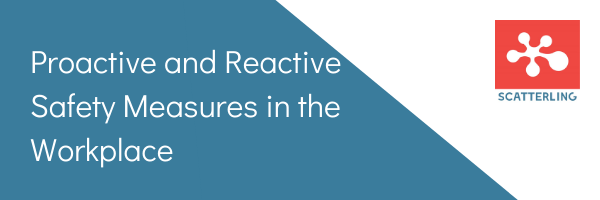This blog article is part 1 of 3 part series of Proactive and Reactive Safety Measure in the Workplace.
View Part 2: A Comprehensive Look Into Proactive Safety.
View Part 3: A Comprehensive Look into Reactive Safety.
Employees should feel confident that their health and safety are top priorities in their work environment. Although incidents in the workplace are often unpredictable, exercising proactive safety protocols not only decrease the probability of an accident occurring in the first place, they also make dealing with an incident much more manageable.
A Positive Safety Culture
Safety culture encompasses the expectations, feelings, and perspectives of employees toward the safety of all workers in an organization - it is how safety is managed in the workplace. Of course, taking a proactive approach to building a positive safety culture will have a large impact on your company. A positive safety culture can lower staff turnover, reduce absenteeism, lower training costs, decrease workplace accidents, reduce possible insurance claims, and have a positive effect on your company’s reputation. In general, a happier group of employees will be more productive and produce higher quality work. Hence, a positive safety culture is something that’s worth being proactive about.
Proactive vs Reactive Safety
Proactive Safety
In short, proactive safety measures entail any tactics employed to minimize the likelihood of an incident taking place. Being proactive means anticipating accidents, being prepared, minimizing response times, decreasing the number of injuries that occur in the workplace, and as a result, reducing the number of worker’s compensation claims.
Read more: A Comprehensive Look Into Proactive Safety
Reactive Safety
In comparison, reactive safety measures are essentially the opposite. A perceived advantage of operating under this method is saving money. However, both the direct and indirect costs of a workplace injury are notable. With unexpected expenses that could take a toll on your company’s long-term profits, it just isn’t worth the risk. Not to mention, your risk will only increase as your organization grows.
Read more: A Comprehensive Look into Reactive Safety
Download our Free eBook: Proactive and Reactive Safety
Which One Are You?
Here's the important question: Is your company responding to incidents as they happen, or taking preventative measures to avoid incidents before they occur? If you employ a reactive safety regime, you are most likely ‘putting out fires’. In other words, you’re waiting for something bad to happen and then trying to act accordingly. This can be costly and time-consuming, not to mention extremely stressful in the event of an accident. An employer may decide to employ reactive safety measures if they are only considering the direct costs.
Direct and Indirect Costs
However, all workplace accidents involve numerous indirect costs which may exceed the direct costs. There have been many situations where minor accidents that could have been avoided had there been proper preventative safety measures in place, end up destroying a company financially. Time is money, and investing proactively in safety measures has a 100% chance in saving you both. It is true that reactive safety measures leave dollars in your pocket today. But, for every dollar left in your pocket now, it WILL cost you in the future.
There is simply no better ROI than adopting a proactive safety measure, like Scatterling. Let’s have a look at some real numbers:
A single workplace injury can incur a direct cost of $30,000.
The indirect cost associated with this injury can go as high as $33,000.
This gives a total of $63,000.
But these figures don’t just represent a loss. Breaking even on that loss of profit is considerable.
At 2.78%, just covering the indirect cost requires an additional $1,187,050 of income.
This brings the total cost up to $2,266,187!
Indirect costs that result from a workplace injury may include training a replacement employee, lost productivity, repairs to damaged equipment or property, and any costs associated with a lowered employee morale. These costs are often intangible and difficult to put a price on, but they should never be ignored in a cost-benefit analysis.
Why Scatterling?
Scatterling will provide you and your company with both qualitative and quantitative benefits.
As discussed, proactive safety measures are profitable in their own right – they don’t just save time and money. Keeping money in your pocket by neglecting necessary safety expenditures is not a forward-thinking strategy and it will cost you in the future. The price of Scatterling will offset the small amount of money that you save by not allocating sufficient budget to safety. That being said, the value of Scatterling far outweighs the price. We are the most cost-effective way to protect your workers, secure your bottom line, and look after your workers.
View Part 2: A Comprehensive Look Into Proactive Safety.
View Part 3: A Comprehensive Look into Reactive Safety.
Still need to convince your boss?
Schedule a consultation today and let us provide you a custom cost-benefit analysis for your company.




